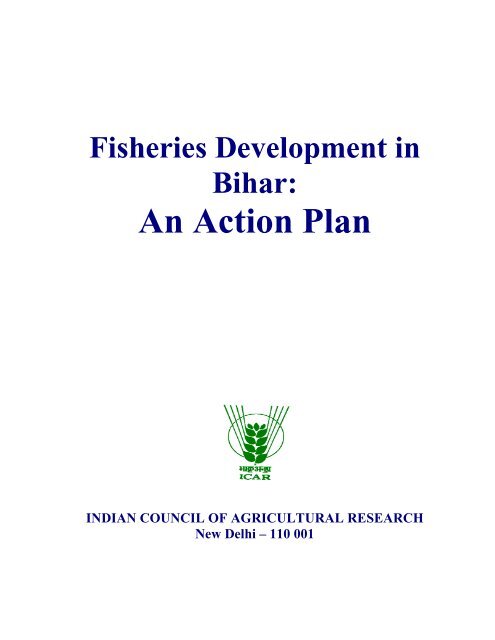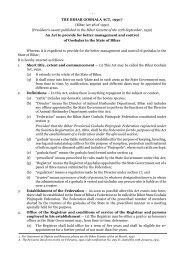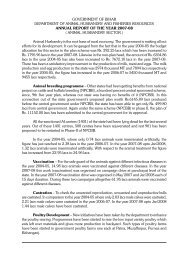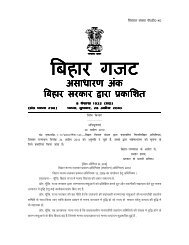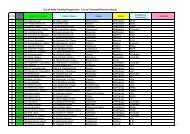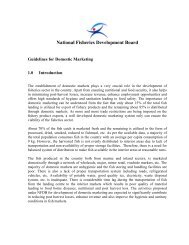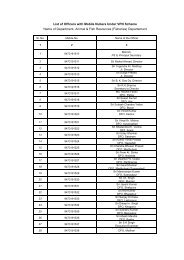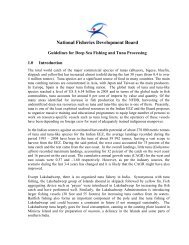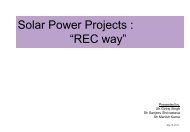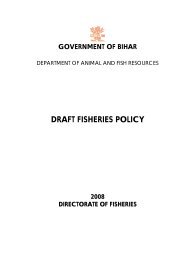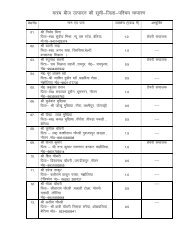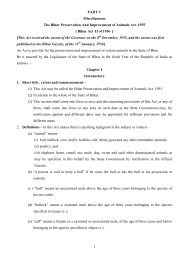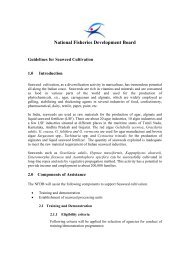Fisheries Development in Bihar - Animal & Fish Resources
Fisheries Development in Bihar - Animal & Fish Resources
Fisheries Development in Bihar - Animal & Fish Resources
- No tags were found...
You also want an ePaper? Increase the reach of your titles
YUMPU automatically turns print PDFs into web optimized ePapers that Google loves.
<strong><strong>Fish</strong>eries</strong> <strong>Development</strong> <strong>in</strong><strong>Bihar</strong>:An Action PlanINDIAN COUNCIL OF AGRICULTURAL RESEARCHNew Delhi – 110 001
<strong><strong>Fish</strong>eries</strong> <strong>Development</strong> <strong>in</strong> <strong>Bihar</strong>: An Action Plan1. IntroductionDespite abundant aquatic resources <strong>in</strong> terms of about 3,200 km of rivers, 100,000hectares chaurs and floodpla<strong>in</strong> wetlands, 9,000 hectares of oxbow lakes or mauns, 7,200hectares of reservoirs and 69,000 hectares of ponds and tanks, fish supply is short of demand<strong>in</strong> the State of <strong>Bihar</strong>. <strong>Development</strong> of the resources with the adoption of the availabletechnologies can bridge this gap, by at least doubl<strong>in</strong>g the production from the present level of2.6 lakh tonnes.Aquaculture and culture-based fisheries are the options for enhanc<strong>in</strong>g the productivityof more amenable waters such as ponds and the oxbow lakes (mauns) with immediate results.An analysis of the constra<strong>in</strong>ts br<strong>in</strong>gs out the <strong>in</strong>adequate availability of quality fish seed <strong>in</strong>terms of carp f<strong>in</strong>gerl<strong>in</strong>gs as a major problem. The present fish production of 350 million frywould need to be tripled to cater to the seed requirements for doubl<strong>in</strong>g the fish production.Further, the weed <strong>in</strong>festations and silt accumulation <strong>in</strong> these waters, the latter due to frequentfloods <strong>in</strong> northern <strong>Bihar</strong>, are the other concerns. Feed requirement <strong>in</strong> aquaculture has neverbeen addressed <strong>in</strong> the past and would become an important <strong>in</strong>gredient for enhanc<strong>in</strong>g fishproduction from culture practices. Both the water resources and the high first sale price offish <strong>in</strong> the State allow for <strong>in</strong>creas<strong>in</strong>g productivity <strong>in</strong> these waters, without reduc<strong>in</strong>g the profitmarg<strong>in</strong>s. At the same time, it is essential to build the market l<strong>in</strong>kages and <strong>in</strong>frastructure forfish market<strong>in</strong>g <strong>in</strong> terms of customised cold cha<strong>in</strong>s to reach fish to different parts of the Stateand beyond. In <strong>Bihar</strong>, fish culture is largely undertaken <strong>in</strong> waters given on lease basis andpractised by fishers who were basically catch<strong>in</strong>g fish from rivers and lakes. In view of thefact that more and more agri-farmers are tak<strong>in</strong>g to aquaculture <strong>in</strong> the recent years, capacitybuild<strong>in</strong>g is critical for adoption of practices <strong>in</strong> a scientific manner.While fisheries development is be<strong>in</strong>g undertaken <strong>in</strong> different water bodies withcomponents of <strong>in</strong>centives for seed and other <strong>in</strong>puts, the meet<strong>in</strong>g taken by the Chief M<strong>in</strong>isterat Patna on 29 th December, 2007 desired an Action plan for enhanc<strong>in</strong>g fish production <strong>in</strong> theState to about 4.5 lakh tonnes with<strong>in</strong> a time frame of 4-5 years. The present document is aroad map for <strong>in</strong>creas<strong>in</strong>g fish production <strong>in</strong> two of the resources, viz., Ponds and Mauns. Ittakes <strong>in</strong>to account the resources available <strong>in</strong> different Districts and the mapp<strong>in</strong>g that has beendone for water bodies above 0.5 hectare <strong>in</strong> each and every Block of the State (Annexure-I).Major <strong>in</strong>terventions proposed are clearance of weed <strong>in</strong>festations, renovation of ponds anddesilt<strong>in</strong>g (with l<strong>in</strong>kages with NREGP), establishment of brood banks and hatcheries toenhance seed production three-fold, provision of seed rear<strong>in</strong>g space with buy-backarrangements, long-term leas<strong>in</strong>g of water bodies, ensur<strong>in</strong>g proper stock<strong>in</strong>g of ponds with6,000 f<strong>in</strong>gerl<strong>in</strong>gs/ha and mauns at 2,000/ha, provision of post-harvest fish handl<strong>in</strong>g andmarket<strong>in</strong>g facilities.1
3 rd year:Expenditure:Rs. 801,800 (Rec. costs, weed clearance,desilt<strong>in</strong>g and 10% depreciation of fixed costs)Gross Return: Rs. 4,800,000Net Return Rs. 3,998,200Table 5. Seed rais<strong>in</strong>g <strong>in</strong> pens <strong>in</strong> mauns with a unit area of 0.1 ha to produce 50,000f<strong>in</strong>gerl<strong>in</strong>gs <strong>in</strong> one cycleUnit cost, Rs.Total cost, Rs.A. Initial expenditureBamboo, 125 nos. 80/pc 10,000Velon screen net, 600 m 10/m 6,000Black pa<strong>in</strong>t, 20 lt 100/lt 2,000Nylon thread, 20 kg 100/kg 2,000Labour for construction, 50 100/manday 5,000mandaysSub Total A 25,000B. Recurr<strong>in</strong>gSeed, 100,000 fry 80/1000 fry 8,000Feed, @ 1% of body weight 3,200Medic<strong>in</strong>e, etc. 500Sub Total B 11,700Grand Total (A+B) 36,700Each pen would yield 50,000 f<strong>in</strong>gerl<strong>in</strong>gs. 200,000 f<strong>in</strong>gerl<strong>in</strong>gs from a set of four pens<strong>in</strong> once cycle are adequate for stock<strong>in</strong>g 100 ha of mauns. As the life of pen enclosure is threeyears, there would be no costs on the pens dur<strong>in</strong>g the second and the third year.Mauns, be<strong>in</strong>g common property resources, are better managed under a comanagementregime through participation of all stakeholders <strong>in</strong>clud<strong>in</strong>g the fishers,community organizations and the Government agencies. Participation of the Governmentwill ensure compliance with national policies and norms of environmental susta<strong>in</strong>ability andequity. Right to erect pen enclosures can be leased out to <strong>in</strong>dividuals, if found necessary andfeasible. However, outright auction<strong>in</strong>g of lakes to <strong>in</strong>dividuals needs to be discouraged <strong>in</strong>order to ensure that the fruits of higher productivity achieved through development <strong>in</strong>itiativesare shared equitably by the fishers, who constitute the ma<strong>in</strong> stakeholders. As poorgovernance and <strong>in</strong>stitutional arrangements have been identified as one of the major retardantsto oxbow lake productivity, this needs to be addressed on a priority basis.4. Support systems on a PPP modeFrom the above account on development of 50,000 hectares of ponds and 5,000hectares of mauns, it is evident that there are three critical aspects that need to be addressed,viz., (i) provision of quality seed; (ii) cost-effective supplementary feed; and (iii) market<strong>in</strong>frastructure for enhanc<strong>in</strong>g productivity as well as ensure profitability. It is suggested that6
Table 8. Unit Cost for Seed Production Centre (spawn 1.6 crore and 0.12crore fry production)(Rs. <strong>in</strong> lakhs)ParticularsAmountA. Non-recurr<strong>in</strong>gHatchery unit (1.5 Lakh/Unit) 1.50Water pumps (1nos) 0.25Nets and hapas 0.50Brood hold<strong>in</strong>g pond (0.6ha) 0.90Nursery pond 1ha (@Rs.1.5 Lakh/ha) 1.50Sub Total A 4.65B. Recurr<strong>in</strong>gProcurement of raised brood 0.80Feed and fertilizer 0.35Hormone and chemicals 0.10Wages 0.15Miscellaneous 0.10Sub Total B 1.50Total 6.15IncomeRs. <strong>in</strong> lakhFrom sale of 1.6 crore spawn @Rs.500/- per lakh Rs 0.80From sale of 0.12 crore fry @Rs.100/- per thousand Rs 1.20From sale of spent brood fish (@80/- per kg) Rs. 0.64Total (spawn, fry and fish) Rs. 2.64Recurr<strong>in</strong>g Expenses (-) Rs. 1.50Net ProfitRs. 1.14 (5 months)A critical <strong>in</strong>put for the hatcheries is the quality broodstock of carps. The Governmentcan play a key role <strong>in</strong> provision of broodstock to the hatcheries <strong>in</strong> terms of its collection andma<strong>in</strong>tenance. A schematic representation of the brood banks and seed production units isgiven <strong>in</strong> Fig. 1. It is suggested that 25 brood banks are set up <strong>in</strong> the potential areas of seedproduction, with provisions for transport of broodstock, prior to the breed<strong>in</strong>g season. Thebank could collect river<strong>in</strong>e fish stocks or procure from other farms. Each brood bank wouldma<strong>in</strong>ta<strong>in</strong> about 3 tonnes of broodstock that would suffice for four seed production units.9
Fig. 1. Schematic Representation of Brood Bank and Seed Production CentresAdvancedf<strong>in</strong>gerl<strong>in</strong>g/yearl<strong>in</strong>g/broodfishcollectionfromdifferentsources andbrooderrais<strong>in</strong>gRequirement foreach brood bankBrood fish to beraised: 3,200 kg (@800 kg for eachproduction unit);Rear<strong>in</strong>g pond: 2 ha (@1,600 kg/ha stock<strong>in</strong>gdensity)Brood Banks12345678910111213141516171819202122232425Seed production units1012342 crore spawn production capacityeach (Sale of 1.2 crore spawn forrear<strong>in</strong>g <strong>in</strong> others’ ponds with buybackarrangements and rear<strong>in</strong>g of0.8 crore spawn <strong>in</strong> own farm forf<strong>in</strong>gerl<strong>in</strong>g production)Requirement for seed production UnitsBrooder hold<strong>in</strong>g ponds: 3-4 ponds (0.5 ha)Nursery pond for fry rais<strong>in</strong>g: 10 ponds (0.5ha)Brood fish: 800 kg (400 kg male & 400 kgfemale which <strong>in</strong>clude 20% buffer stock)Breed<strong>in</strong>g days required: 20 days (40 lakhspawn/ cycle)Spawn<strong>in</strong>g Pool: 1Hatch<strong>in</strong>g Pool: 4
Facilities like electricity, road and water will be needed to be provided. The unit costof establishment and operation of brood banks works out to about Rs. 5.05 lakh per bank, asgiven <strong>in</strong> Table 9.Table 9. Unit cost for Brood bank(Rs. <strong>in</strong> lakhs)ParticularsTotalA. Non-recurr<strong>in</strong>gExcavation of pond with 2 m depth (@Rs 1.53.00*lakh/ha) for 2 haWater pumps (1 no.) 0.25Nets and hapas 0.50Sub Total A 3.75B. Recurr<strong>in</strong>gCost of seed 0.10Feed and fertilizer 0.50POL 0.10Wages 0.50Miscellaneous 0.10Sub Total B 1.30Total 5.05*If not available <strong>in</strong> the unitIncomeRs. <strong>in</strong> lakhFrom sale of brood fish 3200 kg (@Rs.100/- per kg) Rs. 3.20Recurr<strong>in</strong>g Expenses (-) Rs. 1.30Net ProfitRs. 1.90 (18 months)4.2 Feed production unitsThe annual requirement of supplementary feed for aquaculture <strong>in</strong> ponds and seedrear<strong>in</strong>g <strong>in</strong> mauns as <strong>in</strong>dicated above is about 3 lakh tonnes. The ma<strong>in</strong> <strong>in</strong>gredients are mostlyrice bran or wheat bran, groundnut or mustard oilcake. While ready formulated fish feeds areavailable from private manufactures from other States, animal and fish feed manufacturerscould be <strong>in</strong>vited to establish fish feed plants <strong>in</strong> two places <strong>in</strong> the State.Efforts would be required at assessment and collection of agro-by products such asbrans and oilcakes, for provid<strong>in</strong>g ready access to fish farmers. It is suggested that the feedoutlets are established at the seed production units, from where the farmers could draw boththe seed and feed. Customised feed mill designs are available at a cost of around Rs. 8 lakh,for produc<strong>in</strong>g about 100 kg feed <strong>in</strong> a day (about eight hours). This would suffice for a clusterof about 10 hectares, without add<strong>in</strong>g much to the overhead costs. On a pilot basis, 50 unitscould be set up near the respective District Headquarters. On-farm preparation of feed11
mixture is a common practice <strong>in</strong> other States, that could be propagated with some tra<strong>in</strong><strong>in</strong>g <strong>in</strong>stor<strong>in</strong>g of feed <strong>in</strong>gredients, mix<strong>in</strong>g and dispens<strong>in</strong>g <strong>in</strong> gunny bags or trays <strong>in</strong> the ponds.4.3 Post harvest and market<strong>in</strong>g <strong>in</strong>frastructureConsumer preference for fish is <strong>in</strong> the form of fresh fish <strong>in</strong> most parts of the State andfish commands a high price as compared to other States. Hence, the emphasis would need tobe laid on speedy transfer of fish from production to consumption centres, without add<strong>in</strong>gmuch to the costs. Good roads have been emphasised as a necessity for the purpose, as <strong>in</strong> thecase of other agricultural commodities.With almost uniform demand for fish across the State, it is necessary to build coldcha<strong>in</strong>s from those places where fish production is expected to <strong>in</strong>crease by several folds <strong>in</strong> thecom<strong>in</strong>g years, for l<strong>in</strong>k<strong>in</strong>g to major markets. Possibilities of send<strong>in</strong>g fish outside <strong>Bihar</strong> fromborder<strong>in</strong>g Districts to neighbour<strong>in</strong>g States like West Bengal and Orissa may be explored.Simple cold cha<strong>in</strong>s, with tricycle rickshaw as developed by ICAR (Fig. 2) to carry about 80kg fish to a distance of 30 km, would be suitable for production centres <strong>in</strong> rural areas.Fig. 2. Tricycle rickshaw designed for short cold cha<strong>in</strong>In places where around a tonne of fish is expected every month either from mauns orfrom ponds, it is suggested that collection centres are set up and fish transported over adistance of 150-200 km, packed <strong>in</strong> bamboo basket or PVC boxes, <strong>in</strong> four wheelers such asm<strong>in</strong>i-trucks. A model for handl<strong>in</strong>g fish land<strong>in</strong>g to the extent of 10,000 tonnes/year is givenbelow.The model envisages sett<strong>in</strong>g up common collection centres and transportation of thecollected fish <strong>in</strong> chilled condition to 30 retail centres for sale. There will be adequate facilityfor stor<strong>in</strong>g the chilled fish, display of the chilled fish and sale. The basic <strong>in</strong>frastructurerequired for a fish collection centre is transportation and chilled storage. The transportationcomponent comprises five <strong>in</strong>sulated vehicles, either three wheelers or four wheelers with<strong>in</strong>sulated cab<strong>in</strong> capacity of 250-500 kg. The <strong>in</strong>sulated vehicles shall br<strong>in</strong>g ice and transportchilled fish (iced) from land<strong>in</strong>g centre to the collection centre. Alternatively, there can be two<strong>in</strong>sulated vehicles with higher capacity (2 tonnes) depend<strong>in</strong>g on the extent of area to becovered.The Collection centre (Fig. 3) will have facilities for produc<strong>in</strong>g ice (10 tonnes perday), ice storage (2.5 tonnes), <strong>in</strong>sulated storage (5 tonnes), fish display area (500 sq. ft),change room, store for <strong>in</strong>sulated boxes, etc., along with water purification and effluenttreatment provisions. Alternatively, fishes collected can be chilled to ensure better shelf lifefor the chilled fish as well as additional <strong>in</strong>come for the fishers.12
Fig. 3. Layout of fish collection centreD - DoorCD - Chute DoorW - W<strong>in</strong>dowETP - Efficient Treatment TankWPS - Water Purification SystemThe Retail centre (Fig. 4) will consist of a kiosk of 80 sq. ft. built <strong>in</strong> area with an<strong>in</strong>sulated display box, which can display fish <strong>in</strong> chilled condition to the consumers. Therewill also be provision for a soak-pit to sanitarily dispose the waste water generated <strong>in</strong> theretail centre. Each retail centre will be cost<strong>in</strong>g around Rs.60,000/-. Thirty such retail centresare planned <strong>in</strong> selected locations for sell<strong>in</strong>g the river<strong>in</strong>e fish received <strong>in</strong> the Collection centre.The budget for the model is given <strong>in</strong> Table 10.13
Fig. 4. Layout of fish retail kioskTable 10. Budget for a Collection centre and 30 retail centres to handle 10,000 tonnesfish per yearItemCost, Rs.Transportation facility 800,000Collection Centre: 1,500 sq. ft. build<strong>in</strong>g, Ice Unit, Water purification 4,800,000system, Effluent treatment plantRetail Centre (30 nos.) 1,800,000Others 200,000Total 7,600,00014
5. Framework for action planA step-wise framework for implementation of the action plan for development ofponds and mauns is given <strong>in</strong> Table 11.Table 11. Framework for implementation of action planA. <strong>Fish</strong> productivity enhancementSl.No.Resource Target productivity Area, ha Output,tonnes/year1 Ponds 3 t/ha/year 30,000 90,000Ponds 5 t/ha/year 20,000 100,0002 Mauns 960 kg/ha/year 5,000 4,800B. Steps proposed for action planSl.No.Steps Agency Time frameApp. budget(Rs. crore)* forthe first year1. Pondsa Leas<strong>in</strong>g; Renovation Government; Farmers June, 2008(Provision: Rs.60,000/ha forrenovation; 80%from banks and 20%subsidy = Rs. 60crore for 50,000 ha;@ 25% with 75%from Central funds or10% and 90% fromNFDB(with FFDA / assistancefrom NFDB)b Seed stock<strong>in</strong>g andculture operations(Provision: Rs.30,000/ha for <strong>in</strong>puts:80% from banks and20% subsidy = Rs. 30crore for 50,000 ha;@ 25% with 75%from Central funds or10% and 90% fromNFDBFarmer groups (withFFDA/assistance fromNFDB)2 phases: Aug.-Sep. 2008;Aug.-Sep. 2009* With implementation under the exist<strong>in</strong>g Central Sector Schemes, contribution of the StateGovernment towards subsidy component is <strong>in</strong>dicated25.0 (<strong>in</strong>clud<strong>in</strong>gcont<strong>in</strong>gencies)15
2. Maunsa Desilt<strong>in</strong>g, weedclearance, sluicegates & organiz<strong>in</strong>glesseesGovernment; Farmergroups (with funds fromRKVY)2 phases:Through 2008(I <strong>in</strong> mauns withongo<strong>in</strong>gactivities and II<strong>in</strong> new maunsb Sett<strong>in</strong>g up pens Farmer groups After Sep. 2008cSeed stock<strong>in</strong>g andculture operations3. Brood banksa Sett<strong>in</strong>g up broodbanks (25)b Sett<strong>in</strong>g up seedproduction units(100)4. Feed production unitsa Community feedunits (50)b Feed mills <strong>in</strong> privatesector (2)5. Post-harvest <strong>in</strong>frastructurea Collection centres(4) andtransportationarrangementsb Tricycle rickshawsfor fish transport (50nos. @ Rs. 20,000each); 5 ice plants;conta<strong>in</strong>ers fortransport6. Laboratorya Laboratory for soilwatertest<strong>in</strong>g and fishdiseases7. Capacity build<strong>in</strong>ga Tra<strong>in</strong><strong>in</strong>g of officersof the State <strong><strong>Fish</strong>eries</strong>Department andfarmersFarmer groupsGovernment; <strong>in</strong> theexist<strong>in</strong>g farms andleas<strong>in</strong>g out toentrepreneurs)Government; <strong>in</strong> theexist<strong>in</strong>g farms andleas<strong>in</strong>g out toentrepreneurs)Government; leas<strong>in</strong>g outto entrepreneursFacilitation byGovernmentGovernment; leas<strong>in</strong>g outto entrepreneursGovernment; leas<strong>in</strong>g outto entrepreneursGovernment (with fundsfrom CentralGovernment with FFDA)Government (with fundsfromCentralGovernment with NFDBand FFDA)2 phases: Aug.-Sep. 2008;Aug.-Sep. 20092 phases: 2008and 20092 phases: 2008and 2009Through 2008Through 2008Through 2008Through 2008Through 2008Cont<strong>in</strong>uousprocess through2008-201010.0 (<strong>in</strong>clud<strong>in</strong>gcont<strong>in</strong>gencies)10.0 (<strong>in</strong>clud<strong>in</strong>gcont<strong>in</strong>gencies)5.0 (<strong>in</strong>clud<strong>in</strong>gcont<strong>in</strong>gencies)6.0 (<strong>in</strong>clud<strong>in</strong>gcont<strong>in</strong>gencies)16
The document provides a framework for fisheries development <strong>in</strong> <strong>Bihar</strong> with specificreferences to ponds and mauns, beg<strong>in</strong>n<strong>in</strong>g with seed up to retail outlets. Some of thecomponents could be addressed through the ongo<strong>in</strong>g schemes, while <strong>in</strong> others, appropriatemechanisms <strong>in</strong>clud<strong>in</strong>g public-private partnerships would need to be put <strong>in</strong> place. The role ofthe Government could be facilitatory, with sett<strong>in</strong>g up models <strong>in</strong> different areas and the staffof the Department of <strong><strong>Fish</strong>eries</strong> assigned the work. If the area, approach and action l<strong>in</strong>e<strong>in</strong>dicated are agreed <strong>in</strong> pr<strong>in</strong>ciple, then an early meet<strong>in</strong>g be convened for f<strong>in</strong>alization of thedocument and draw<strong>in</strong>g of an implementable schedule of operation <strong>in</strong> a Mission mode<strong>in</strong>clud<strong>in</strong>g identification of agencies and schemes, on-course correction measures, output,outcome and impact.17


